2015 AUDI Q5 ESP
[x] Cancel search: ESPPage 177 of 302
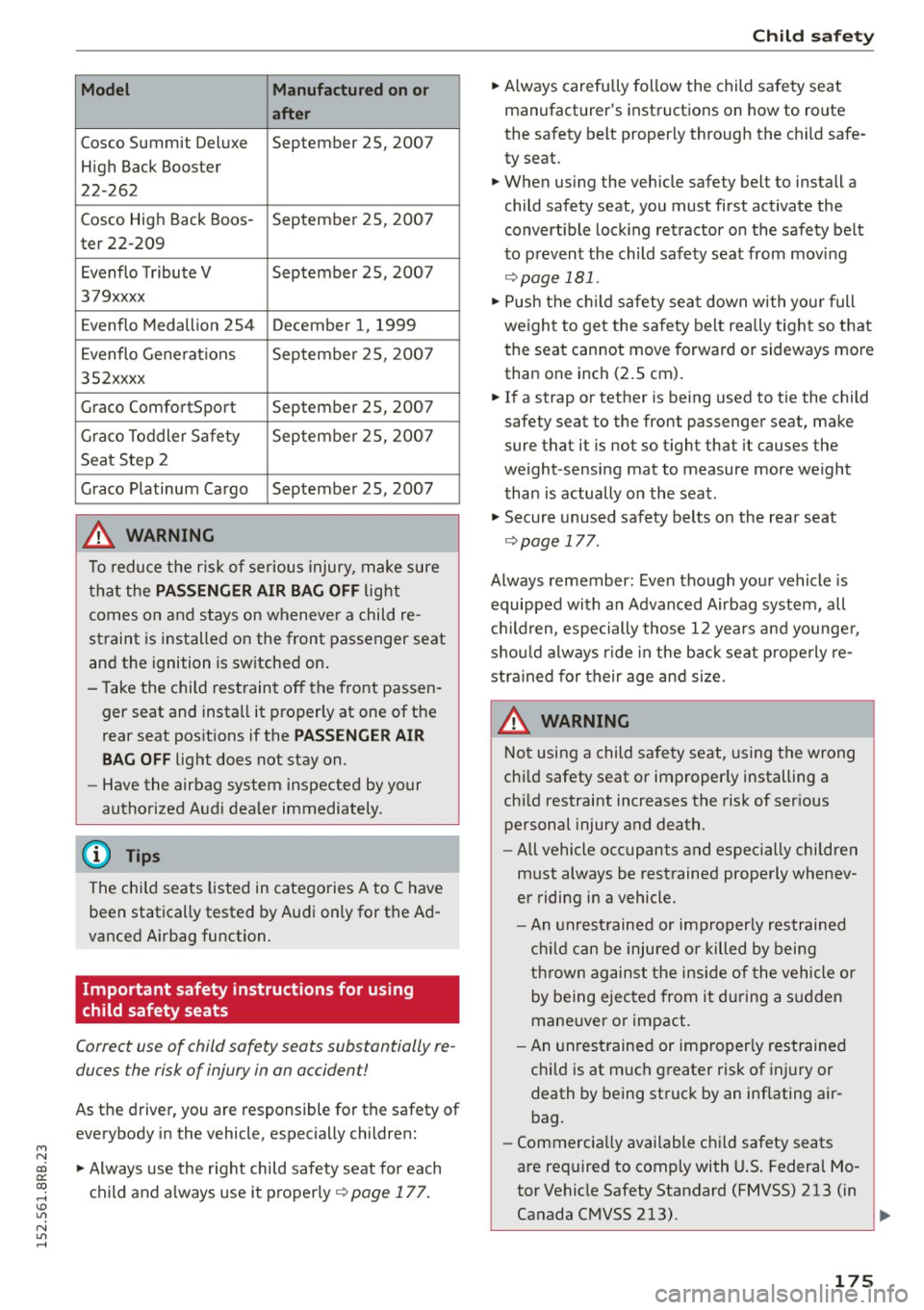
M N
co
a:
co
,...., \!) 1.1'1
N 1.1'1 ,....,
Model Manufactured on or
a fter
Cosco Summit Deluxe September 25, 2007
High Back Booster
22-262
Cosco High Back Boos -September 25, 2007
ter 22-209
Evenflo Tribute V September 25, 2007
379xxxx
Evenflo Medallion 254 December 1, 1999
Evenflo Generations September 25, 2007
3S2xxxx
Graco ComfortSport September 25, 2007
Graco Toddler Safety September 25, 2007
Seat Step 2
Graco Platinum Cargo September 25, 2007
.&, WARNING
To reduce the risk of serious injury, make sure
that the
PASS ENGER AIR BAG OFF light
comes on and stays on whenever a child re
straint is installed on the front passenger seat
and the ignition is switched on.
- Take the child restraint off the front passen ger seat and install it properly at one of the
rear seat positions if the
PASSENGER AIR
BA G OFF
light does not stay on.
- Have the airbag system inspected by your
authorized Audi dealer immediately.
(D Tips
The ch ild seats listed in categories A to C have
been statically tested by Audi on ly for the Ad
vanced Airbag function.
Important safety instructions for using
child safety seats
Correct use of child safety seats substantially re
duces the risk of injury in an accident!
As the driver, you are responsible for the safety of
everybody in the vehicle, especially children:
.,. Always use the right child safe ty seat for each
child and a lways use it properly ¢
page 177.
Child sa fety
.,. Always carefully follow the child safety seat
manufacturer's instructio ns on how to route
the safety belt properly through the child safe
ty seat.
.,. When using the vehicle safety belt to install a
child safety seat, you must first activate the
convert ible lock ing retractor on the safety belt
to prevent the child safety seat from mov ing
r::) page 181 .
.,. Push the ch ild safety sea t down with yo ur full
weight to get the safety belt rea lly tight so that
the seat cannot move forward or sideways more
than one inch (2.5 cm).
.,. If a strap or tether is being used to tie the child
safety seat to the front passenger seat, make
sure that it is not so tight that it causes the
weight -sensing mat to measure more we ight
than is actually on the seat .
.,. Secure unused safety belts on the rear seat
r::) page 177 .
Always remember : Even though your vehicle is
equipped with an Advanced Airbag system, all
c hi ld ren, especially those 12 years and younge r,
shou ld a lways r ide in the back seat prope rly re
stra ined for their age and size.
A WARNING
=
Not using a child sa fety seat, us ing the wrong
chi ld safety seat or improperly installing a
chi ld restraint increases the risk of serious
personal injury and death.
- All vehicle occ upants and especially children
must always be restrained properly whenev
er riding in a vehicle .
- An unrest rained or improperly restrained
ch ild can be injured or killed by being
thrown against the ins ide of the vehicle o r
b y being ejected from it du ring a s udden
maneuver or impact.
- An unrestrained or improperly res trained
child is at much greater risk of injury or
death by being struck by an inflating air
bag.
- Commercia lly available child safety seats
are req uired to comply with U.S. Federa l Mo
tor Vehicle Safety Standard (FMVSS) 213 (in
Canada CMVSS 213). .,_
175
Page 179 of 302
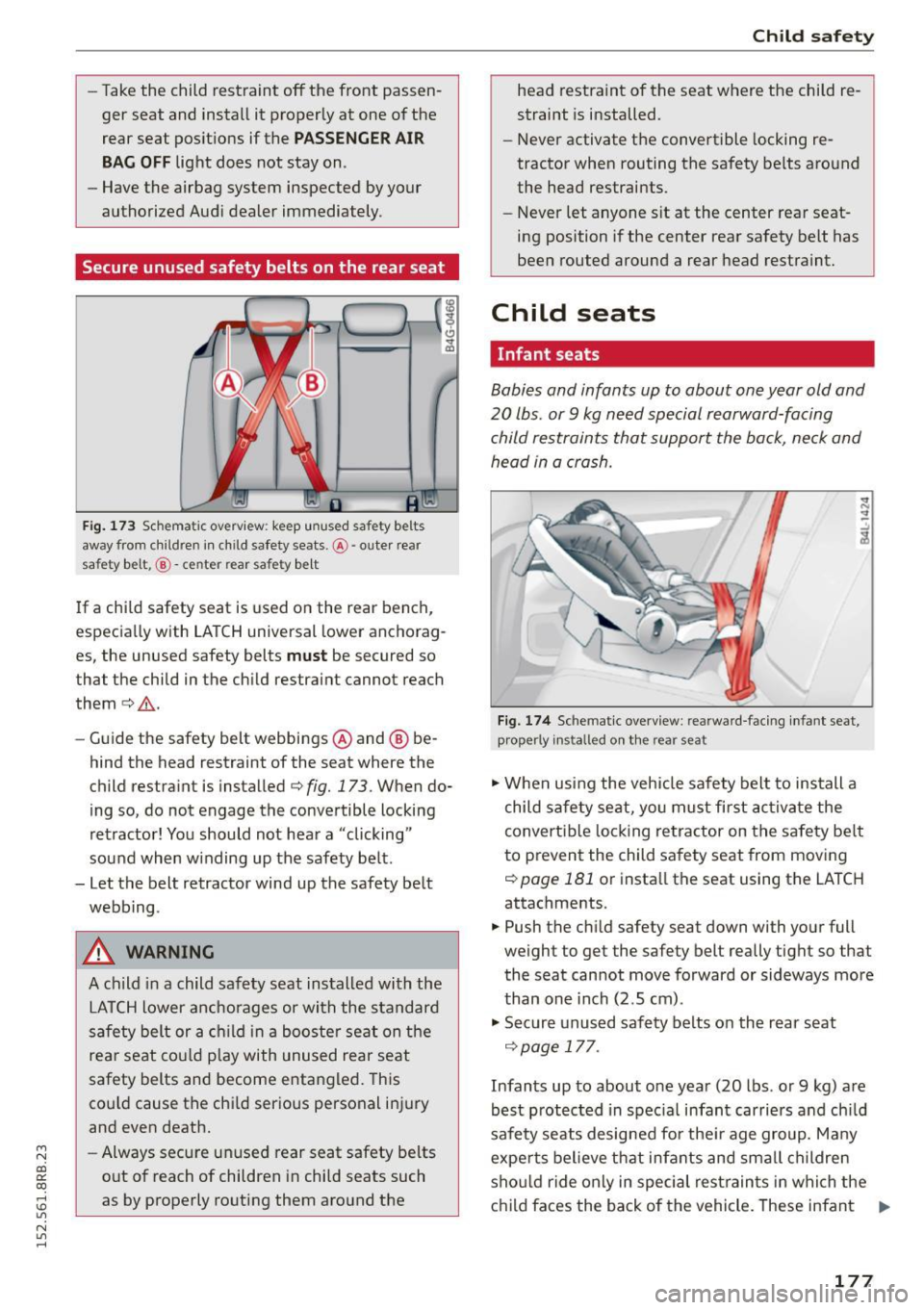
M N
co ~ co
rl I.O
"' N
"' rl
-Take the child restraint off the front passen
ger seat and install it properly at one of the
rear seat pos itions if the
PASSENGER AIR
BA G OFF
light does not stay on.
- Have the airbag system inspected by your
authorized Audi dealer immediately.
Secure unused safety belts on the rear seat
Fig . 173 Schematic overview: keep unused safety belts
away from children in child safety seats. @-oute r rear
safety belt,
@ -center rea r safety belt
If a chi ld safety seat is used on the rear bench ,
especia lly with LATCH universal lower anchorag
es, the unused safety belts
must be secured so
that the child in the child restraint cannot reach
them¢ _&.
- Guide the safety belt webbings @and @ be
hind the head restraint of the seat where the
child restraint is installed¢
fig. 173. When do
ing so, do not engage the convertible locking
retractor! You should not hear a "clicking"
sound when w inding up the safety belt.
- Let the belt retractor wind up the safety belt
webbing .
A WARNING
A child in a child safety seat installed with the
LA TCH lower anchorages or with the standard
safety belt or a ch ild i n a booste r seat on the
rea r seat co uld play with unused rear seat
safety belts and become entangled. This
co uld cause the chi ld serious personal inj ury
and even death.
- Always secure un used rear seat safety belts
o ut of reach of children in child seats such
as by properly routing them around the
Chil d sa fe ty
head restra int of the seat where the child re
straint is installed.
- Never activate the convertible locking re
tractor when routing the safety belts around
the head restraints.
- Never let anyone s it at the center rear seat
ing position if the center rear safety belt has
been routed around a rear head restraint.
Child seats
Infant seats
Babies and infants up to about one year old and
20 lbs . or
9 kg need special rearward-facing
child restraints that support the back, neck and
head in a crash.
F ig. 174 Schemat ic overv iew : rearward -fac ing infant seat,
proper ly installed on th e rear seat
., W hen using the vehicle safety belt to install a
child safe ty seat, yo u must first ac tivate the
convert ib le lock ing retractor on the safety be lt
to prevent the child sa fety seat from mov ing
i=:> page 181 or insta ll the seat using the LATCH
attachments.
.. Push the child safety seat down with your full
weight to get the safety belt really tight so that
the seat cannot move forward or sideways more
than one inch (2.5 cm).
., Secure unused safety belts on the rear seat
¢page 177.
Infants up to about one year (20 lbs. or 9 kg) are
best p rotected in spec ial infant carriers and ch ild
safety seats designed for the ir age group. Many
expe rts bel ieve that infants and sma ll children
sho uld ride only in special restrain ts in which the
child faces the back of the vehicle. These infant .,.
177
Page 182 of 302

Child safety
Booster seats and safety belts
Properly used booster seats can help protect
children weighing between about 40 lbs. and 80
lbs. (18 kg and 36 kg) who are less than 4
ft. 9
in. (57 inches/1.45 meters) tall .
Fig. 177 Rear seat: child prope rly restrained in a booste r
seat
The vehicle's safety belts alone will not fit most
children until they are at least 4
ft. 9 in . (57 in
ches/1.45 meters) tall and weigh about 80 lbs. (36 kg) . Booster seats raise these children up so
that the safety belt will pass properly over the
stronger parts of their bodies and the safety belt
can help protect them in a crash .
• Do not use the convertible locking retractor
when using the vehicle's safety belt to restrain
a child on a booster seat.
• The shoulder belt must lie as close to the cen
ter of the child's collar bone as possible and
must lie fla t and snug on the upper body. It
must never lie across the throat or neck . The
lap belt must lie across the pelvis and never
across the stomach or abdomen . Make sure the
belt lies flat and snug. Pull on the belt to tight
en if necessary.
• If you must transport an older child in a boos
ter seat on the front passenger seat, you can
use the safety belt height adjustment to help
adjust the shoulder portion properly .
• Secure unused safety belts on the rear seat
c> page 177.
Children up to at least 8 years old (over 40 lbs. or
18 kg) are best protected in child safety seats de
signed for their age and weight. Experts say that
the skeletal structure, particularly the pelvis, of
these children is not fully developed, and they
180
must not use the vehicle safety belts without a
suitable child restra int .
It is usually best to put these children in appro
priate booster seats . Be sure the booster seat
meets all applicable safety standards.
Booster seats raise the seating position of the
child and reposition both the lap and shoulder
parts of the safety belt so that they pass across
the child's body in the right places. The routing of
the belt over the child's body is very important
for the child's protection, whether or not a boos
ter seat is used. Children age 12 and under must
always ride in the rear seat .
Ch ildren who are at least 4
ft. 9 in. (57 inches/
1.45 meters) tall can generally use the vehicle's
three point lap and shoulder belts. Never use the
lap belt portion of the vehicle's safety belt alone
to restrain any child, regardless of how big the
child is. Always remember that children do not
have the pronounced pelvic structure required for
the proper function of lap belt portion of the ve
hicle's three point lap and shoulder belts . The
child's safety absolutely requires that a lap belt
portion of the safety belt be fastened snugly and
as low as possible around the pelvis. Never let
the lap belt portion of the safety belt pass over
the child 's stomach or abdomen.
In a crash, airbags must inflate within a blink of
an eye and with considerable force . In order to do
its job, the airbag needs room to inflate so that it
will be there to protect the occupant as the occu
pant moves forward into the airbag .
A vehicle occupant who is out of position and too
close to the airbag gets in the way of an inflating
airbag. When an occupant is too close, he or she
will be struck violently and will receive serious or possibly even fatal injury .
In order for the airbag to offer protection, it is
important that all vehicle occupants, especially
any children, who must be in the fron t seat be
cause of exceptional circumstances, be properly
restrained and as far away from the airbag as
possible. By keeping room between the child's .,,.
Page 183 of 302
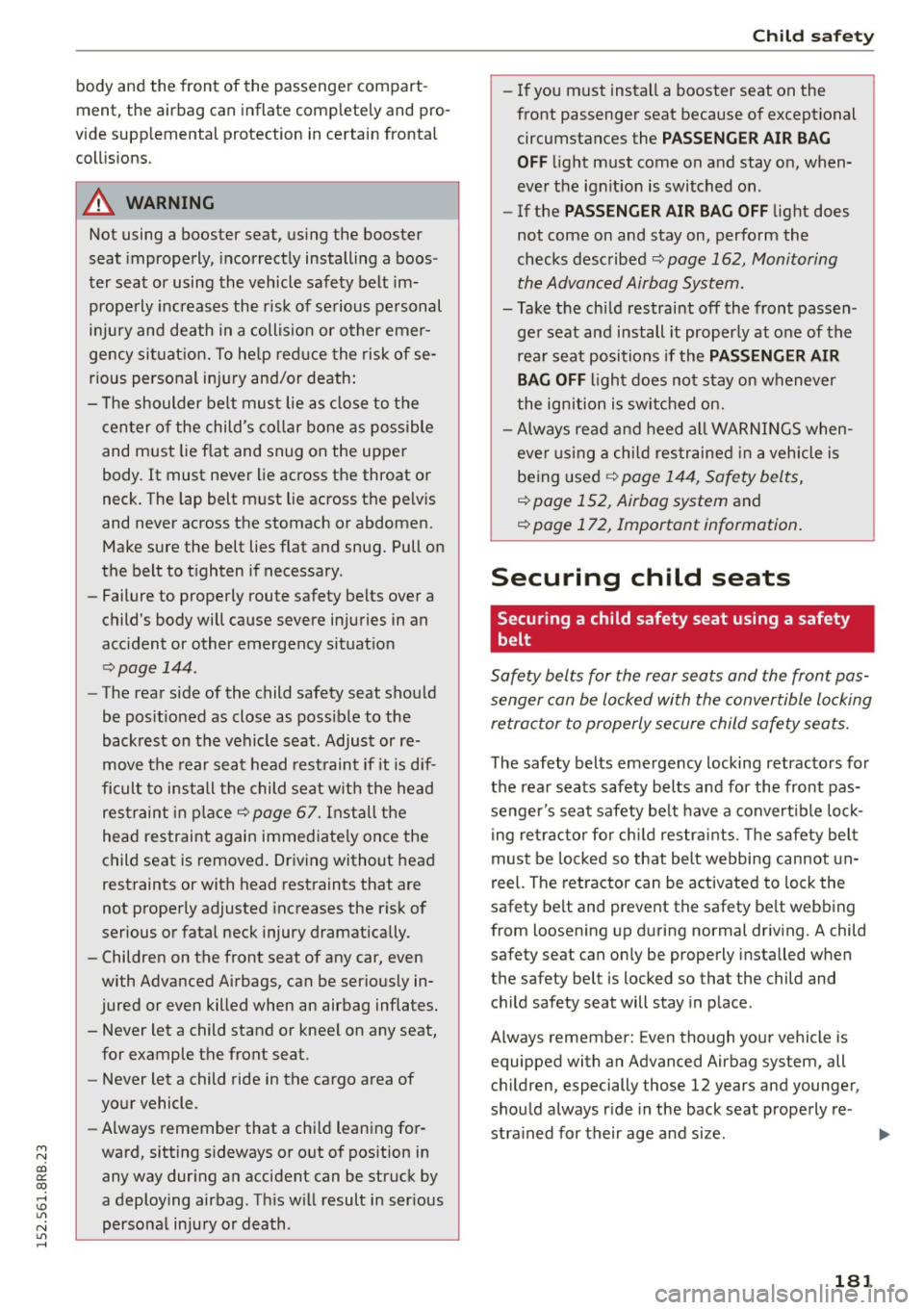
M N
co
a:
co
,...., \!) ..,.,
N ..,., ,....,
body and the front of the passenger compart
ment, the airbag can inflate comp letely and pro
vide supp lemental protection in certain frontal
coll is ions .
& WARNING
Not using a booster seat, us ing the booster
seat imprope rly, incorrect ly installing a boos
ter seat or using the vehicle safety belt im prope rly increases the r isk of se rious personal
injury and death in a collision or other emer
gency sit uat ion. To he lp reduce the risk of se
r ious personal inju ry and/or death:
- T he shoulder be lt mus t lie as close to the
c en ter o f the child's co llar bone as possible
and must lie f lat and snug on the uppe r
body.
It must never lie across the throat o r
neck . The lap belt m ust lie across the pelv is
and never across the stomach or abdomen.
Make sure the belt lies flat and snug. Pull on
the belt to t ighten if necessary.
- Failure to properly route safety belts over a
child's body will cause severe in juries in an
acc ident or other emergency situat ion
~ page 144.
-The rea r side of the child safety seat shou ld
be pos it ioned as close as poss ible to the
backrest on the vehicle seat . Adjust or re
move the rear seat head rest raint if it is d if
ficult to install the child seat w ith the he ad
res traint in p lace
~ page 67. Inst all the
head restraint again immed iate ly once the
child seat is removed . Dr iv ing without head
restraints or with head rest raints that are
not prope rly adjusted inc reases the r isk o f
serious or fatal neck injury dramatically.
- Children on the front seat of any car, even
with Advanced Airbags, can be ser ious ly in
jured or even killed when an airbag inflates.
- Never let a child stand or knee l on any seat,
for example the front seat.
- Never let a child ride in the cargo area of
yo ur vehicle.
- Always remember that a chi ld lean ing fo r
ward, sitting s ideways or o ut o f pos ition in
any way dur ing an accident can be struck by
a deploying airbag. Th is w ill result in ser ious
persona l inju ry or death .
Child sa fety
- If you must install a booster seat on the
front passenge r seat because o f exceptional
circumstances the
PASSENGER AIR BAG
OFF
li ght must come on and stay on, when
eve r the ignit ion is switched o n.
- If the
PASSENGER AIR BAG OFF light does
not come on and stay on, perform the
checks desc ribed
~ page 162, Monitoring
th e Advanc ed Airbag System.
- Take t he chi ld restraint off the fron t passen
ge r seat and install it properly at one of the
rea r seat posi tions if the
PASSENGER AIR
BAG OFF
ligh t does n ot stay on whenever
the igni tion is switched on.
- Always read and heed al l WARN IN GS when
eve r using a child res tra ine d in a vehicle is
be ing used ¢
page 1 44, Safety belts,
¢ page 152, Airbag system and
¢ page 172, Important information .
Securing child seats
Securing a child safety seat using a safety
belt
Safety belts for the rear seats and the front pas
senger can be lock ed with th e conv ertible locking
retrac tor to properly secure child safety seats.
The safety belts emergency locking retracto rs fo r
the rea r seats safety belts an d for the front pas
senger 's seat safety be lt have a convert ible lo ck
i ng re tr acto r fo r child restr aints. The safety be lt
must be loc ked so that belt webbing cannot un
reel. The ret ractor can be activated to lock the
safety belt and prevent the safety be lt webb ing
from loosen ing up d uring normal driv ing. A child
safety seat can on ly be properly installed when
the safety belt is locked so that the child and c h ild safety seat will stay in p lace .
Always remember: Even tho ugh your vehicle is
equipped with an Advanced Airbag system, all
c hi ldren, especially those 12 years and younge r,
shou ld always r ide in the back seat prope rly re
stra ined for their age and size.
181
Page 185 of 302
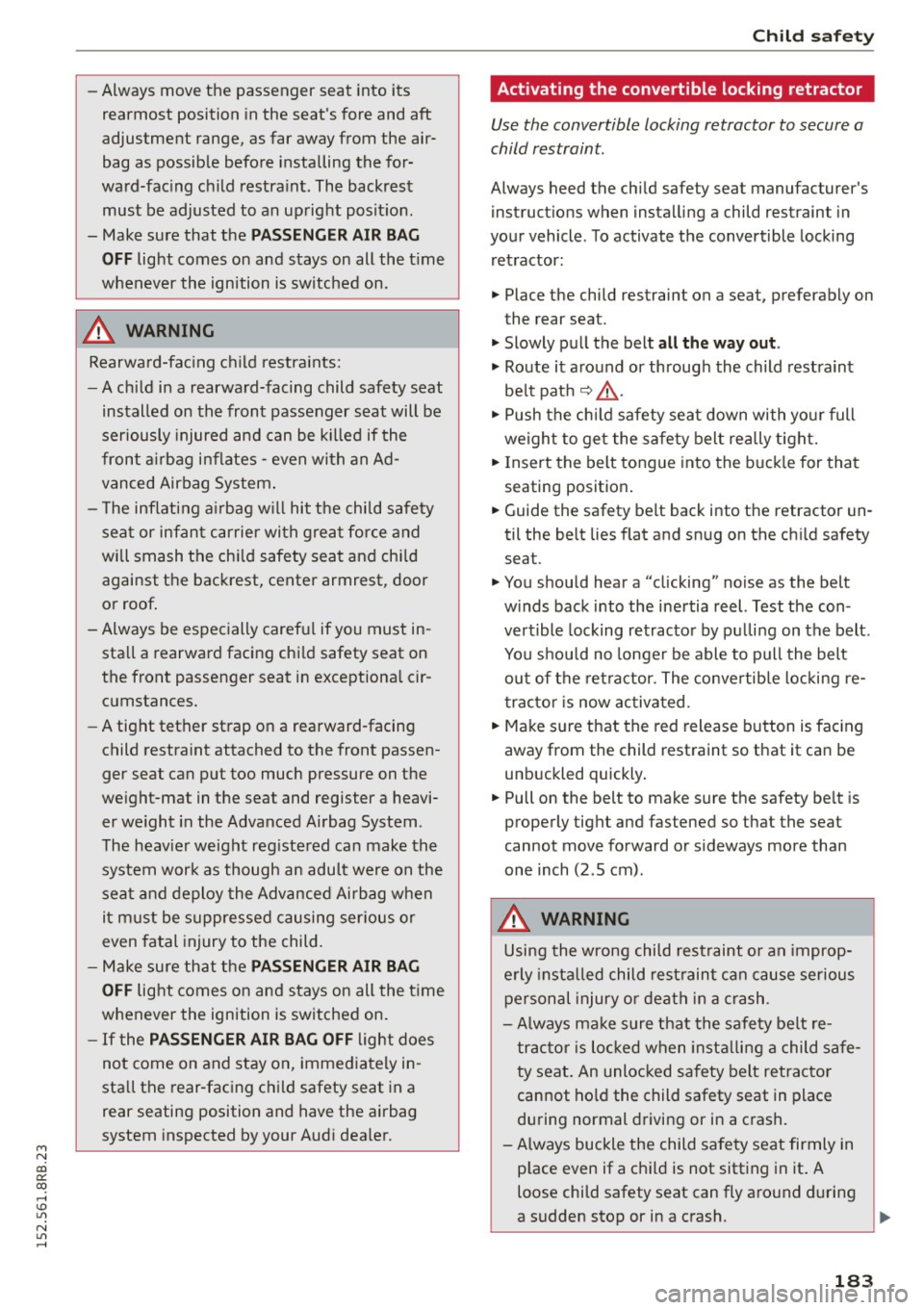
M N
co
a:
co
,...., \!) 1.1'1
N 1.1'1 ,....,
-Always move the passenger seat into its
rearmost position in the seat's fore and aft
adjustment range, as far away from the air
bag as possible before installing the for
ward-facing child restraint. The backrest must be adjusted to an upright position.
- Make sure that the
PASSENGER AIR BAG
OFF
light comes on and stays on all the time
whenever the ignition is switched on.
A WARNING
Rearward-facing child restraints:
-A child in a rearward-facing child safety seat
installed on the front passenger seat will be
seriously injured and can be killed if the
front airbag inflates - even with an Ad
vanced Airbag System.
- The inflating airbag will hit the child safety
seat or infant carrier with great force and
will smash the child safety seat and child
against the backrest, center armrest, door
or roof.
- Always be especially careful if you must in
stall a rearward facing child safety seat on
the front passenger seat in exceptional cir cumstances.
- A tight tether strap on a rearward-facing
child restraint attached to the front passen
ger seat can put too much pressure on the
weight-mat in the seat and register a heavi er weight in the Advanced Airbag System.
The heavier weight registered can make the
system work as though an adult were on the
seat and deploy the Advanced Airbag when
it must be suppressed causing serious or
even fatal injury to the child.
- Make sure that the
PASSENGER AIR BAG
OFF
light comes on and stays on all the time
whenever the ignition is switched on.
- If the
PASSENGER AIR BAG OFF light does
not come on and stay on, immediately in
stall the rear-facing child safety seat in a
rear seating position and have the airbag
system inspected by your Audi dealer.
Child safety
Activating the convertible locking retractor
Use the convertible locking retractor to secure a
child restraint .
Always heed the child safety seat manufacturer's
instructions when installing a child restraint in
your vehicle . To activate the convertible locking
retractor:
.. Place the child restraint on a sea t, preferably on
the rear seat.
.. Slowly pull the belt all the way out.
.. Route it around or through the child restraint
belt path
~ . & .
.. Push the child safety seat down with your full
weight to get the safety belt really tight.
.. Insert the belt tongue into the buckle for that
seating position.
.. Guide the safety belt back into the retractor un
til the belt lies flat and snug on the child safety
seat .
.. You should hear a "clicking" noise as the belt
winds back into the inertia reel. Test the con
vertible locking retractor by pulling on the belt .
You should no longer be able to pull the belt
out of the retractor. The convertible locking re
tractor is now activated .
.. Make sure that the red release button is facing
away from the child restraint so that it can be
unbuckled quickly.
.. Pull on the belt to make sure the safety belt is
properly tight and fastened so that the seat
cannot move forward or sideways more than
one inch (2 .5 cm) .
A WARNING
Using the wrong child restraint or an improp
erly installed child restraint can cause serious
personal injury or death in a crash .
- Always make sure that the safety belt re
tractor is locked when installing a child safe
ty seat. An unlocked safety belt retractor
cannot hold the child safety seat in place
during normal driving or in a crash.
- Always buckle the child safety seat firmly in place even if a child is not sitting in it. A
loose child safety seat can fly around during
a sudden stop or in a crash. ..,.
183
Page 190 of 302
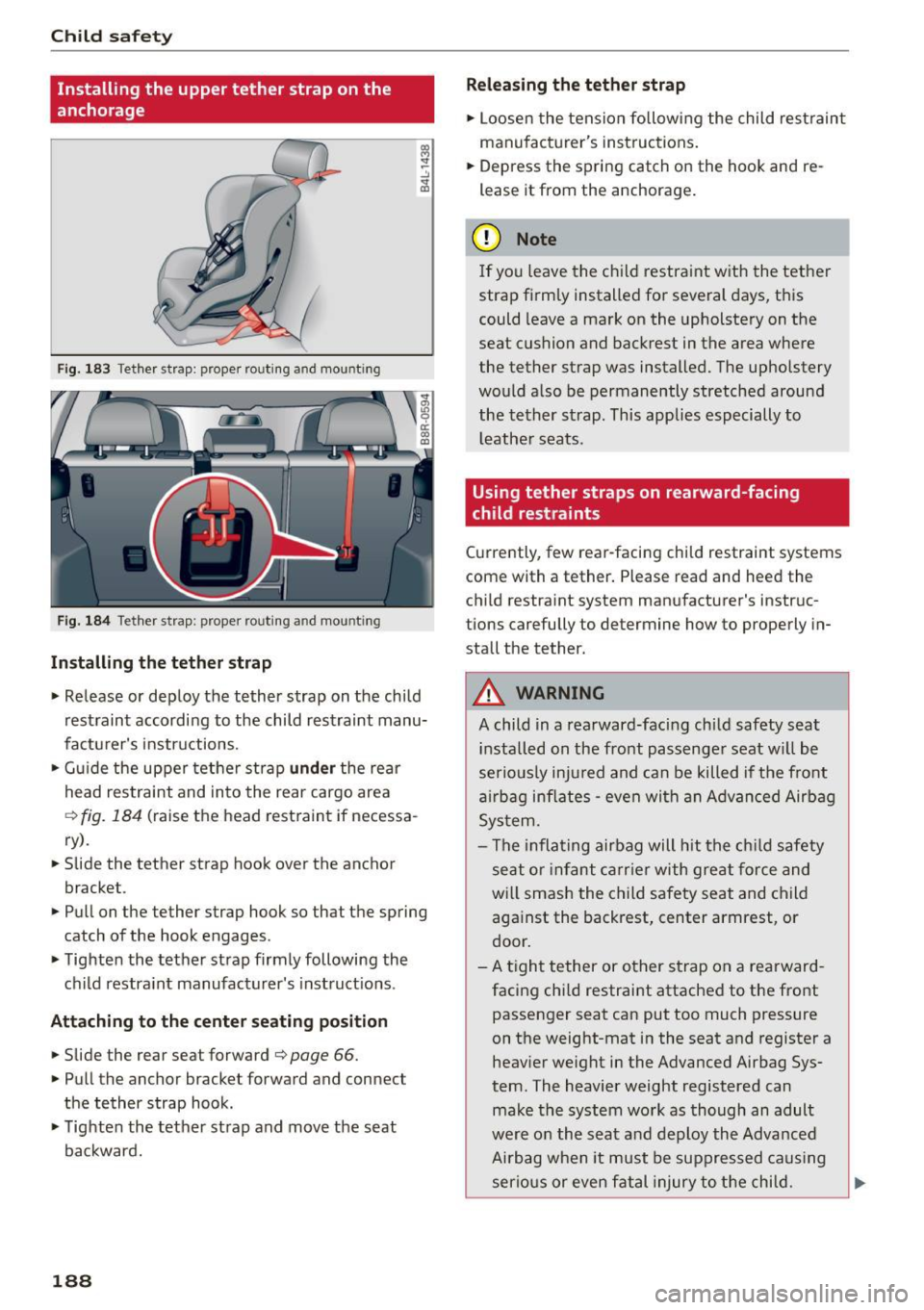
Child safety
Installing the upper tether strap on the
anchorage
F ig . 183 Tether strap: proper routing and mounting
F ig . 18 4 Tether st rap: proper routing and mounting
Installing the tether strap
• Release or dep loy the tether strap on the child
restraint according to the child restraint manu
factu rer's instr uctions.
• Gui de the upper te ther strap
under the rear
head restraint and into the rear cargo area
¢ fig. 184 (raise the head restraint if necessa
ry).
• Slide the tether strap hook over the anchor
bracket.
• Pull on the tether strap hook so that the spring
catch of the hook engages .
• Tighte n the tether st rap firmly following the
c h ild restra int manufac turer's inst ruct ions .
Attaching to the center seating position
• Slide the rear seat forward ¢ page 66.
• Pull the anchor bracket forward and connect
the tether strap hook .
• Tig hte n the tet her strap and move the seat
backward.
188
Releasing the tether strap
• Loosen the tension fo llow ing the child rest raint
manu fact urer's inst ructions.
• Depress the spring catch on the hook and re
lease it from the anchorage .
(D Note
If you leave the ch ild restraint with the tet her
strap fi rm ly installed fo r several days, t his
could leave a mark on the upholstery on the
seat cushion and backrest in the area where
the tether strap was installed. The upholstery
would a lso be permanently stretched around
the tether s trap . This applies especially to
l ea ther seats.
Using tether straps on rearward-facing
child restraints
Curre ntly, few rear -facing chi ld restraint systems
come with a tether. Please read and heed the
ch ild restra int system manufacturer's instr uc
tions carefully to determine how to properly in
stall the tether.
A WARNING
A child in a rearward-facing ch ild safety sea t
i nstalled on the fro nt pass enge r seat w ill be
seriously inju red and can be killed if the front
air bag in flates - even with an A dvan ced Air bag
Sys tem.
- The infla ting airbag will h it the c hild safety
seat o r infant carrier with great force and
w ill smash the child safety seat and child
aga inst the backrest, center armrest, or
door.
- A t igh t tether or other s trap on a rearward
facing chi ld restraint attached to the front
passenger seat can put too much pressure
on t he weight-mat in the seat and register a
heav ier weight in the Advanced Airbag Sys
tem. The heavier weight registered can
ma ke the system wo rk as though an adult
were o n the seat and deploy the Advanced
Airbag when it must be suppressed ca us ing
ser io us or even fat al injury to t he child.
~
Page 193 of 302

M N
co
a:
co
,...., \!) 1.1"1
N 1.1"1 ,....,
shared, please see your contract with the
wireless telecommunications provider and the
"About Aud i connect" tab in your vehicle's
MMI*:
IMENU I button> Audi connect > About
Audi connect .
Electronic Stabilization
Control (ESC)
Description
The Electronic Stabilization Control (ESC) reinfor
ces driver safety. It reduces the risk of slipping
and improves driving stability. ESC detects criti
cal s ituations such as the vehicle oversteering
and understeering or the wheels sp inning. The
veh icle is stab ilized by applying the brakes or re
ducing engine torque. Once the ESC is act ive, the
indicator light
m blinks in the instrument clus
ter.
The fol low ing systems a re integrated in the ESC:
Anti-lock brake system (ABS)
ABS prevents the wheels from locking up when
brak ing . The vehicle can still be steered even dur
ing hard braking. Apply steady pressure to the
brake pedal. Do not pump the pedal. A pulsing in
the brake pedal indicates that the system is help
ing you to brake the vehicle.
Brake assist system
The brake assist system can decrease braking d is
tance . It increases braking power when the dr iver
presses the brake pedal quick ly in emergency s it
uations. You must press and hold the brake pedal
unti l the situation is over. In vehicles w ith adap
tive cruise control*, the brake assist system is
more sensitive if the distance detected to the ve
hicle ahead is too small.
Anti-slip regulation (ASR)
ASR reduces engine power when the drive whee ls
begin to spin and adapts the force to the road
conditions. This makes it easier to start, acceler
ate and drive up hills.
Smart Technology
Electronic differential lock (EDL)
The EDL brakes whee ls that are spinning and
trans fers the drive power to the other whee ls.
This function is not avai lable at higher speeds .
In extreme cases, EDL automatically sw itches off
to help keep the brake on the braked wheel from
overheating. EDL will switch on again automati
ca lly when conditions have returned to normal.
Steering recommendation
The ESC helps to stabilize the vehicle by changing
the steering torque.
On vehicles with dynam ic steering*, ESC helps
stab ilize the steer ing in crit ical situat ions .
Selective wheel torque control
Selective wheel torque control is used when driv
ing on curves. The front wheel on the inside of
the curve or both wheels on the inside of the
curve are braked select ively as needed. This al
lows more precise driving in curves. The applica
ble system may not activate when driving in wet
o r snowy conditions .
A WARNING
-
-The ESC and its integrated systems cannot
overcome the laws of physics. This is espe
cially important on slippery or wet roads. If
the systems begin acting to stabilize your
vehicle, you should immediately change
your speed to match the road and traffic conditions . Do not let the increased safety
provided by these systems tempt you to
take risks. Doing so will increase the risk of a
loss of vehicle control, collision and serious
personal injuries.
- Always adapt your speed to road, traffic and
weather conditions. The risk of los ing con
trol of the vehicle increases when driving
too fast, especially through curves and on
slippery or wet roads, and when driving too
close to vehicles up ahead . The ESC and its
integrated systems cannot a lways prevent
coll isions - there is st ill a risk of acc idents!
- Always accelerate with special care on even,
smooth surfaces such as those that are wet
or covered with ice and snow. The drive
191
Page 194 of 302

Smart Technology
wheels can spin even with these assistance
systems that cannot always help to reduce
the risk of loss of vehicle control.
@ Tips
-ABS and ASR only work correctly when all
four whee ls are equipped with identical
Switching on/off
tires . Different tire sizes can lead to a reduc
tion in engine power .
- You may hear noises when the systems de
scribed are working.
- When installing a factory-supplied roof rack
system on the roof railing, the ESC will
adapt itself to a different center of gravity.
ESC turns on automatically when you start the engine.
Fig. 185 Version A: Lower center console, YJ. OFF butto n
The fo llow ing situations are exceptions where it
may be useful to sw itch on offroad mode to allow
the wheels to spin:
- Rocking the vehicle to free it when it is stuck
- Driving in deep snow or on loose ground
Offroad mode on
Fig. 186 Ve rs ion B: Upper center co nsole, YJ. O FF button
-Driving with snow chains
- Driving downhill while braking on loose ground
- Driving on rough terrain when much of the car's
weight is lifted off the wheels (axle articula
tion)
Offroad mode off
Behavior
The ESC and ASR stabilization functions are The full stabilization function of the ESC
limited
c> & .
Operation Press the l.13 OFF I button.
Indicator Ill turns on.
lights
Driver mes· Stabilization control (ESC): Offroad .
sages Warning! Restricted stability
A WARNING
- You should only switch offroad mode on if
your driving abilit ies and road conditions
permit.
- The stabilization function is limited when offroad mode is switched on. The driving
wheels cou ld spin and the vehicle could
swerve, especially on slick or slippery road
surfaces.
192
and ASR is availab le again.
Press the
1.$ OFF I button again.
II turns off.
Stabilization control (ESC): On
(D Tips
Offroad mode cannot be switched on when
adaptive cruise control" is switched on .